
- Semiconductor Technology Now
Cross Talk
What is a black hole?
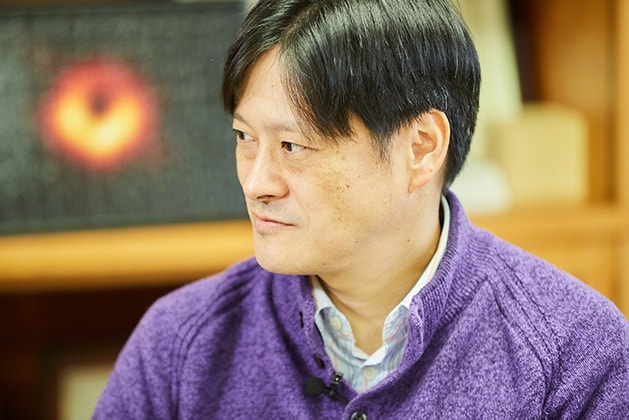 |
Telescope Magazine: In April this year, an international team announced it had successfully captured the first-ever image of a black hole shadow. Professor Honma, you were an active participant and leader of the Japanese team.
Mie Nagata: What type of astronomical object is a black hole?
Mareki Honma: Black holes are very unusual astronomical objects. To start with, they are very small. A black hole is a collapsed star crushed to a size much smaller than our sun, so its gravity is enormous. It sucks in light and gases, and once they enter the hole, nothing can ever escape. The fact that such a mysterious object, a one-way hole, exists in the universe is miraculous in itself.
Mie Nagata: In the past, we didn’t really know if it existed. How was it discovered?
Mareki Honma: In the 1960s, the Cygnus X-1 astronomical object was observed by special electromagnetic waves called X-rays. The X-rays were observed to fluctuate violently for short periods. It indicated that gases were being violently sucked into an extremely small astronomical object, and these X-rays were being emitted from the gases. The supposition was that they were looking at gases falling into a black hole.
Mie Nagata: So, the X-rays were not being emitted by the black hole itself, but by the gases around it?
Mareki Honma: That’s right. A black hole just sucks things in; nothing can escape. The gases spiraling around a black hole form what is known as an accretion disk. As the gases are sucked into the black hole, they become incredibly hot and emit light and X-rays. And that is what we can see.
Trying to see the invisible successfully captures the first-ever image of a black hole shadow
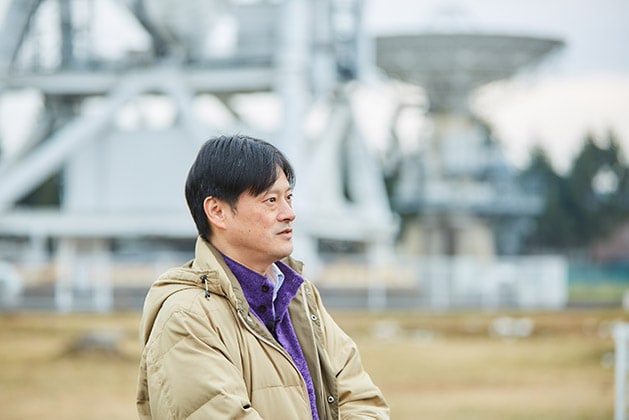 |
Telescope Magazine: Despite understanding the likelihood of black holes existing, they were unable to directly prove their existence. Professor Honma, you and your associates put an end to this dilemma by successfully capturing an image of a black hole shadow. Located 55 million light-years away from Earth, at the center of the Messier 87 (M87) elliptical galaxy in the Virgo cluster of galaxies, is a supermassive black hole with 6.5 billion times the mass of our sun, that you captured.
Mie Nagata: Black holes are invisible, so what made you decide to try and see one?
Mareki Honma: It’s because they are invisible that I wanted to see one. From Cygnus X-1 and other observations, we were almost certain that black holes existed. But no-one had ever seen one. That’s why we decided we would try and see one. A group of 200 or more researchers, including myself, had this desire, so we have been conducting research for five to ten years. It was a long time, but we could never give up our research.
Telescope Magazine: This is the actual image of a black hole shadow that Professor Honma and his team captured (figure 2). But how does this show a black hole?
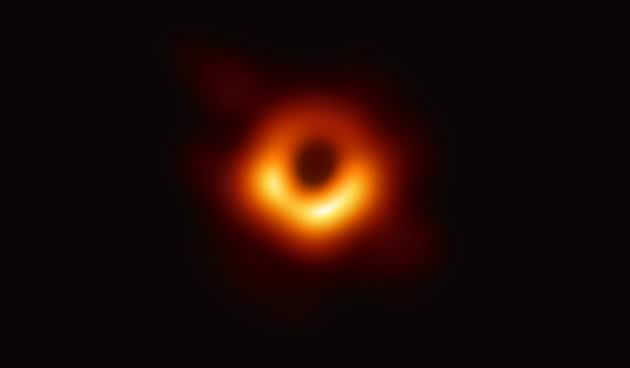 |
Mareki Honma: Start by understanding that a black hole is a sphere. You also have a lot of light rays bent by the extreme gravity that spiral around the black hole. If you look at the black hole in cross section, you see a flat plane like this shaped like a donut. It looks like a ball that has been cut in half—looking at the cross section, in the middle is the black hole and the outside is the halo.
Mie Nagata: You often hear that an image of a black hole was captured, but more accurately, the image is not of a black hole, is it?
Mareki Honma: That’s right. Even light is sucked into a black hole, so it’s impossible to actually see one. The black area in the middle of this image is not a black hole itself, but just the shadow of light being sucked in. We call this a black hole shadow. You can’t see the black hole itself; it’s somewhere further inside this shadow.
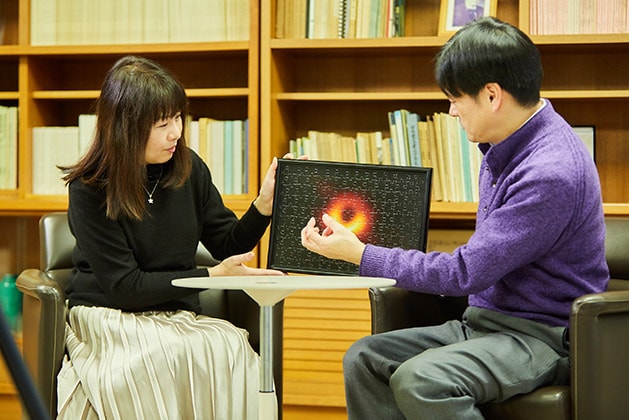 |
Mie Nagata: What is the story behind this achievement of the century?
Mareki Honma: A black hole is a very small astronomical object, so it’s like looking through the eye of a needle from Earth. That is why we needed a telescope with exceptional vision. We then used very long baseline interferometry (VLBI) technology to arrange several radio telescopes in such a way that they can be used as one giant radio telescope.
We used the Event Horizon Telescope (EHT)*1 to capture this image of a black hole shadow. It is actually a group of eight telescopes in six locations around the world, which combined together create a radio telescope the size of the Earth with a diameter of about 10,000 kilometers (figure 3). This gives us unimaginable eyesight three million times more powerful than human eyesight.
We also used radio telescopes that operate on millimeter waves. Compared to the centimeter electromagnetic waves previously used for observations, the millimeter frequency provides much better penetration of the interstellar plasma of galaxies and gases around black holes. Development of, and observations using, millimeter-based telescopes were very difficult, but recent technological progress and international cooperation has made it possible.
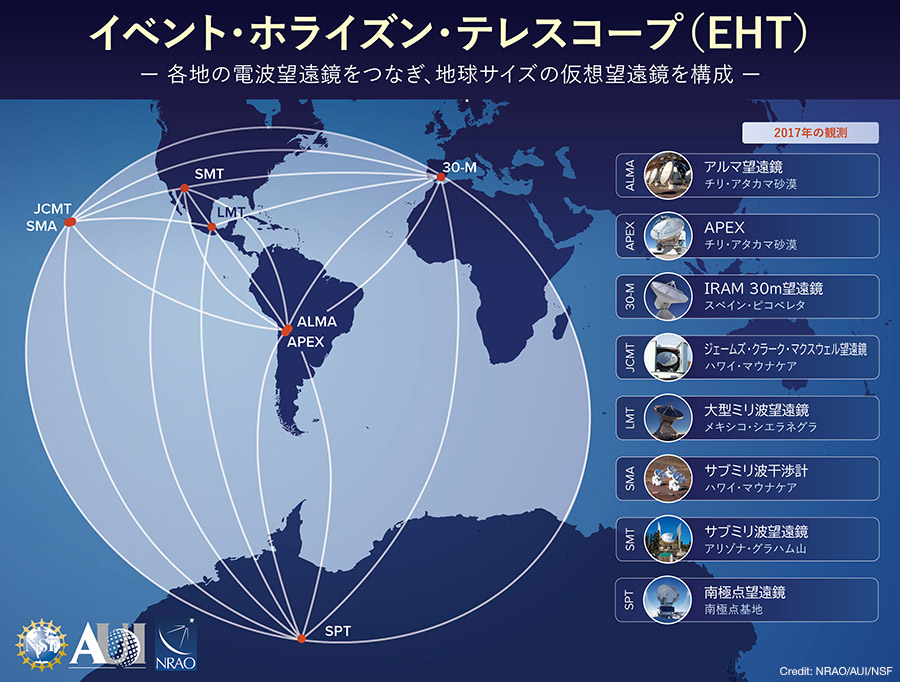 |
Mie Nagata: Researchers from many countries participated, but what contributions was Japan able to make?
Mareki Honma: Globally, more than 200 people were involved in the EHT project, with 14 of them from Japanese research institutes. I was in charge of leading that Japanese team. The Japanese team, for example, developed the technologies for using ALMA*2 in Chile, South America, as part of the EHT array. We also analyzed data for imaging the black hole and wrote papers on the process. In particular, we independently created a technique for analyzing data, which was used to analyze data from the EHT and produce the images. That was an important contribution.
Mie Nagata: Did research teams from other countries also analyze data and develop such techniques as well?
Mareki Honma: We were divided into several teams, and analysis was conducted using three analytical techniques. The Japanese team developed one of those analytical techniques and used it for data analysis. At the beginning, each team kept their techniques to themselves and conducted analysis separately. We did it this way to ensure no errors in our research. By independently analyzing each piece of data and then comparing results, we were able to verify that our findings were correct.
Mie Nagata: From the images analyzed and produced by each country, the ones produced by the Japanese team were particularly good.
Mareki Honma: Yes, I do think the analytical technique that we developed, through the combined efforts of myself and other young researchers in this and other fields, was the best. Luckily, we were able to demonstrate that the new technique could produce better images than previous techniques. Actually, America is also proposing their own analytical technique, but there’s no doubt that their technique has been affected by ours. [laughs] For this and other reasons, I’m happy we were able to contribute to the advancement of research in this field.
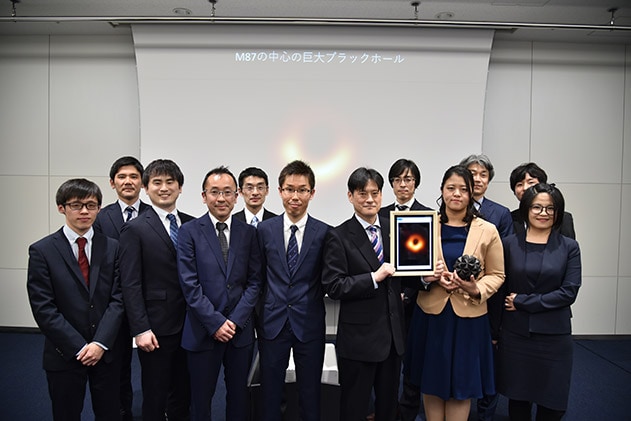 |
Footnotes
- *1
- Event Horizon Telescope (EHT): The EHT is a telescope that operates on a short millimeter wavelength (mainly 1.3 mm) and makes VLBI observations from a base line length of 10,000 kilometers, which is almost the diameter of the Earth. This provides the best resolution ever achieved, equivalent to 3,000,000x vision. Observation data for the current black hole image was collected in 2017 from eight telescopes: APEX (Chile), ALMA (Chile), IRAM 30-meter Telescope (Spain), James Clerk Maxwell Telescope (Hawaii), Large Millimeter Telescope (Mexico), Submillimeter Array (Hawaii), Submillimeter Telescope (Arizona), and South Pole Telescope (South Pole).
- *2
- ALMA: ALMA is a giant radio telescope constructed at a height of 5,000 meters in the mountains of Chile in South America through an international collaboration between Japan and other East Asia countries, North America, European member states of the European Southern Observatory, and Chile. It commenced scientific observations in 2011. With a parabolic array of 66 telescopes (7-meter and 12-meter diameter), it is able to observe astronomical objects using short millimeter and submillimeter waves.



















